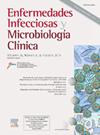Surveillance of catheter-related bacteremia in VINCat program
IF 2.6
4区 医学
Q3 INFECTIOUS DISEASES
Enfermedades infecciosas y microbiologia clinica
Pub Date : 2025-01-17
DOI:10.1016/j.eimc.2024.12.001
引用次数: 0
Abstract
Background
Catheter-related bacteremia (CRB) is one of the most frequent infections acquired during hospitalization. We summarize the results of CRB surveillance conducted by the Catalan Program of Surveillance of Nosocomial Infections (VINCat) over the past fifteen years.
Methods
All episodes of hospital-acquired CRB diagnosed in the 55 Catalan hospitals participating in the VINCat program (2008–2023) were recorded. Annual incidence rates per 1000 patient-days were calculated. Analyses were stratified into three relevant five-year periods: 2008–2012, 2013–2017, and 2018–2022. Incidence rate ratios (IRRs) were used to compare infection rates.
Results
During the study period, 10,212 episodes of nosocomial CRB were diagnosed. The global incidence rate was 0.21 episodes per 1000 patient-days (intensive care units (ICUs): 1.13; medical wards: 0.16; surgical wards: 0.15). Gram-positive bacteria caused 68.3% of the episodes. The incidence rate of CRB acquired in ICUs and that of CRB associated with central venous catheters decreased during the study period, while episodes associated with peripheral venous catheters (PVCs) and peripherally-inserted central venous catheters (PICVCs) significantly increased (p < 0.001).
Conclusions
The current study underscores the necessity for interventional programs targeting PVCs, particularly in non-ICU wards.
VINCat项目中导管相关菌血症的监测
导管相关性菌血症(CRB)是住院期间最常见的感染之一。我们总结了加泰罗尼亚医院感染监测计划(VINCat)在过去15年中进行的CRB监测结果。方法对参与VINCat项目的55家加泰罗尼亚医院2008-2023年诊断的所有医院获得性CRB病例进行记录。计算每1000病人日的年发病率。分析分为三个相关的五年期:2008-2012年、2013-2017年和2018-2022年。发生率比(IRRs)用于比较感染率。结果在研究期间,诊断出10212例院内CRB。全球发病率为每1000患者日0.21例(重症监护病房:1.13例;病房:0.16;外科病房:0.15)。革兰氏阳性菌引起68.3%的发作。在研究期间,icu内获得性CRB的发生率以及与中心静脉导管相关的CRB发生率下降,而与外周静脉导管(pvc)和外周中心静脉导管(picvc)相关的发生率显著增加(p <;0.001)。目前的研究强调了针对室性早搏的介入治疗方案的必要性,特别是在非icu病房。
本文章由计算机程序翻译,如有差异,请以英文原文为准。
求助全文
约1分钟内获得全文
求助全文
来源期刊
CiteScore
2.10
自引率
8.00%
发文量
194
审稿时长
29 days
期刊介绍:
Hoy está universalmente reconocida la renovada y creciente importancia de la patología infecciosa: aparición de nuevos agentes patógenos, de cepas resistentes, de procesos con expresión clínica hasta ahora desconocida, de cuadros de una gran complejidad. Paralelamente, la Microbiología y la Infectología Clínicas han experimentado un gran desarrollo como respuesta al reto planteado por la actual patología infecciosa. Enfermedades Infecciosas y Microbiología Clínica es la Publicación Oficial de la Sociedad Española SEIMC. Cumple con la garantía científica de esta Sociedad, la doble función de difundir trabajos de investigación, tanto clínicos como microbiológicos, referidos a la patología infecciosa, y contribuye a la formación continuada de los interesados en aquella patología mediante artículos orientados a ese fin y elaborados por autores de la mayor calificación invitados por la revista.

 求助内容:
求助内容: 应助结果提醒方式:
应助结果提醒方式:


